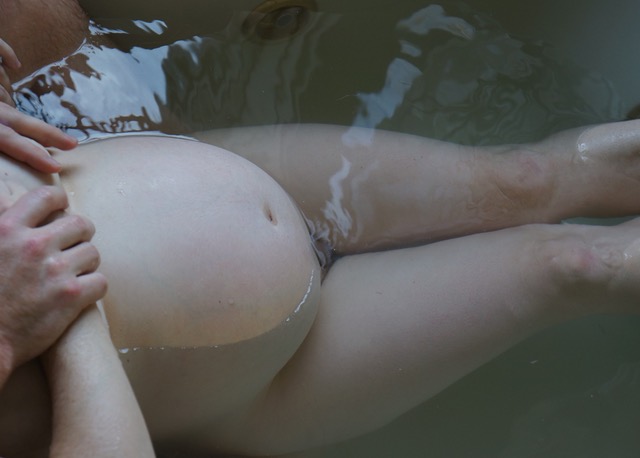Labor is uncomfortable. Women in general are very frightened of the pain associated with labor. This fear keeps many women from even considering natural childbirth. Women who often refrain from taking any medication at all their entire pregnancy will allow very strong medications injected into their epidural space for their delivery. Even when they know that the epidural has many potential negative effects, they will still choose it because they are terrified of experiencing childbirth without it.
If a woman is provided concrete alternatives to epidural anesthesia for the discomforts of labor, she is more likely to consider an unmedicated birth. Water immersion is the single best way to tolerate the pain of labor besides epidural anesthesia. Midwives and doulas use water to their clients’ advantage in many ways. Water is helpful in a tub, in a glass, when frozen and on a washcloth. Most hospitals don’t offer water therapy whereas almost all offer epidurals. Taking a bath in labor (water immersion) is considered riskier than epidurals and cesarean birth by most Obstetricians. Honestly, it is even rare to see a cold washcloth used. There is nothing more comforting to a laboring woman than another person wiping her face and applying cold compresses to her head over and over. In a standard labor and delivery unit, there is no time allotted to staff to monitor a woman in a tub and monitor the fetal heart intermittently instead on continuously. Because of that and, of course, the large number of concerns held by the majority of OB’s and hospital administrations regarding bathing in labor, water immersion and waterbirth are offered in very few hospitals. Water therapies like ice packs, showers, hot packs, and cool cloths are often not offered because they require constant human contact. No machine can replace the comfort of caring human touch. Caring is one of the things all women need in labor.
Water labor and birth has come under attack by the American College of Obstetricians and Gynecologists (ACOG) calling for more studies proving its safety but the American College of Nurse-Midwives (ACNM) has substantial proof of waterbirth safety and they are working hard to publish more data proving the same. The ACNM published a document of protocols for hospitals to use to start water labor and birth programs (source).
The Midwives of New Jersey are convinced that water immersion and birth are safe after attending over 1200 waterbirths since the year 2000 with no poor outcomes associated with the water.
Ways to Use Water in Labor and Birth
Water Immersion
Most people recognize the relaxation that accompanies entering a pool of water. This is the reason we like swimming pools, hot tubs, and bathtubs. In labor, entering a pool of water gives a laboring woman pain relief, freedom of movement, less stress on joints, a feeling of safety, decreased stress hormones, increased endorphins, and increased oxytocin. All these things reduce the need for pharmacologic pain management. A woman in the tub tends to be more independent and in control, assuming the positions that are most comfortable. Women generally experience less labor pain and less pelvic pressure as their baby moves through the pelvis. They report less burning as the baby stretches the perineum and are rarely out of control for the birth itself. With water immersion, women can enter the tub and experience the “ahh” effect. This is when they completely relax in the water and their cervix opens quickly; progressing from even 5cm to delivered in less than an hour.
I have seen it even be quicker, one woman literally entered the tub at 5cm and started pushing in 3 contractions. Women themselves can’t believe the baby could possibly be coming but it can and does happen.
Waterbirth
Delivering the baby into the tub of water has several benefits:
1. Eliminates the need for the birthing mother to move out of the water.
Women often become “fixed” in one spot once the baby is coming out. They find it very difficult to move at all. A woman may need assistance to even turn from one side to another. Waterbirth allows the mother to stay where she has become comfortable.
2. Allows a more independent delivery.
The buoyancy of water makes the mother and the baby float! Immersed women can maintain more upright positions which allows them to catch their own babies and be assured that they cannot drop their baby onto the floor. Delivering the baby by herself is one of the most gratifying birth experiences a woman can have.
3. Promotes physiologic birth
The woman is more able to access her hindbrain and behave more intuitively when her discomfort is reduced. Immersion in a pool of water (the deeper the better) decreases adrenaline and increases endorphins. Hydrostatic pressure gives the woman a feeling of being held and supported. Women say their pain is reduced 50% in the tub which is often tolerable all the way to delivery.
Care providers are not able to interfere with labor as much because women in their hindbrain or “zone” are no longer able to engage in conversation and are generally less aware of the activities and sounds around them. Even listening to the baby with the doppler is less disturbing once the woman has entered the water and her labor “zone”.
The more a woman can turn inward and allow her body to do the work that needs to be done, the less often intervention is needed in her labor and the less likely she is to have complications leading to cesarean birth.
4. Helps the mother control the delivery resulting in less perineal trauma
When women are not in the water, they feel such pain and pressure with the delivery of the baby’s head that they will not tolerate the time it takes for the perineum to stretch and not tear. In the water, women are much more tolerant of the sensations associated with the delivery of the head so they are less likely to have a laceration. Women in the tub often deliver in a supported semi-squat or on their knees which are optimal positions for reducing lacerations.
5. Gentle birth for the baby.
Waterbabies are handed immediately to their mothers, cord blood can return to the baby and mother and baby are less disturbed during the 3rd stage of labor.
Shower
Many hospitals have showers instead of tubs. The steady spray of water can allow the laboring woman to focus inward, to let the contractions “flow”, keep hospital personnel from interrupting your progress-they generally like to avoid getting wet! Hospitals usually have unlimited hot water so the shower time can be longer than in a woman’s home. The sound of running water is soothing to everyone – the laboring woman, her family, and her care providers. Keeping everyone calm is optimal for the promotion of normal birth.
Ice
Applying ice packs to body parts can numb and decrease inflammation. Some women like a cold pack applied to their pubic bone during labor
Hot Water Bottle or Heating Pad or Warm Rice Sock
Heat packs placed on a woman’s lower abdomen or back can reduce pain
Drinking Water/Fluids
Labor is a time of incredible fluid and calorie needs. A woman will need to sip continuously throughout her labor. Avoiding dehydration will keep her body functioning optimally throughout labor. Drinking a cup of milk every hour can reduce labor pain. Try the laborade recipe below to stay hydrated and reduce pain.
Laborade Recipe
What you’ll need:
- 1 32oz. Mason jar with lid
- Juice from 1 lemon
- 1/4 c. raw honey (more or less depending on sweetness preference)
- 1 tsp. Natural Calm (powdered magnesium supplement) (source)
- 1 scoop Calcium Citrate powder (source)
- A pinch of sea salt
- Your choice of filtered water, coconut water, or red raspberry tea (start with the water and see how you like it before adding additional flavors. Red raspberry leaf tea has additional benefits in pregnancy and postpartum.
Here’s what you’ll do:
- (If you will be using the red raspberry leaf tea, prepare it at double-strength and add the honey so that it can dissolve. If no using tea, skip this step.)
- Fill mason jar half-way with the water
- Add the juice of the lemon, honey, magnesium, and salt to the mason jar
- Close the lid and shake like crazy
- Shake and stir until the honey is dissolved
- Fill the rest of the way with water and refrigerate
You can substitute coconut water for regular water for added nutritional benefits!
Water makes of 60% of our bodies and 70% of the Earth’s surface. Turns out, people have a strong affinity to water and all of its benefits. Women should use water in all its forms to make birth more pleasurable.







 Pre-planning pregnancy is a good idea
Pre-planning pregnancy is a good idea
